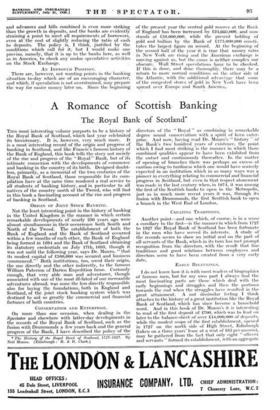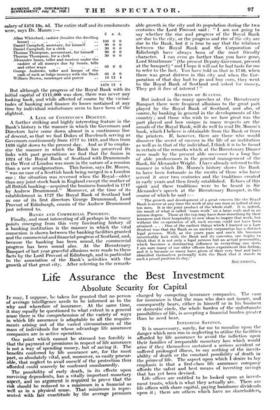A Romance of Scottish - Banking
The Royal Bank of Scotland*
THIS most interesting volume purports to be a history of the Royal Bank of Scotland, which last year celebrated its bicentenary. It is, however, very much more. It is a most interesting record of the origin and progress of banking in Scotland, and like Francis's famous history of the Bank of England, this book tells the story not merely of the rise and progress of the "Royal" Bank, but of its intimate connexion with the developments of commerce and banking in-the country of its birth; Designed doubt- less, primarily, as a memorial of the two centuries of the Royal Bank of Scotland, those responsible for its com- pilation have at the same time rendered a real service to all students of banking history, and in particular to all natives of the country north of the- Tweed, who will find in this book a fascinating account of the rise and progress of banking in Scotland.
ORIGIN OF JOINT STOCK BANKING.
Not the least interesting_point in the history of banking in the United Kingdom is the manner in which certain remarkable developments of nearly 250 years ago were almost simultaneous in their occurrence both South and North of the Tweed. The establishment of both the Bank of England and the Bank of Scotland occurred within a few months of each other, the Bank of England being formed in 1694 and the Bank of Scotland obtaining its statutory credentials on July 17th, 1695, though it was not until the following year, says Dr. Munro, " that its modest capital of £100,000 was secured and business commenced." Both institutions, too, owed their origin, the one directly and the other indirectly, to the famous William Paterson of Darien Expedition fame. Curiously enough, that very able man and adventurer, though associated with one of the most ill-fated of our mercantile adventures abroad, was none the less directly responsible also for laying the foundations, both in England and Scotland, of the joint stock banking system, which was destined to aid so greatly the commercial and financial fortunes of both countries.
CONSERVATISM AND ENTERPRISE.
On more than one occasion, when dealing in the spectator and• elsewhere with latter-day developments in the records of the Royal Bank of Scotland, such as the fusion with Drummonds a few years back and the general progress of the Bank, I have described the policy of the * The History of the Royal Bank of Scotland, 1727-1927. By Neil Munro. (Edinburgh : R. & R. Clark.) directors of the " Royal " as combining in remarkable degree sound conservatism with a spirit of keen enter- prise. And now, having read Dr. Munro's " history " of the Bank's two hundred years of existence, the point which I find most striking is the manner in which tho'se combined qualities appear to have been exhibited from the outset and continuously thereafter. - In the matter of opening of branches there was perhaps an excess of caution owing to tardiness which one :would have scarcely expected in an institution which in so many ways was a pioneer in everything relating to commercial and'financial progress in Scotland, but even in that respect atonement was made in the last century when, in 1874, it was among the first of the Scottish banks to open in the Metropolis, just, as in much more recent years it was, through its fusion with Drummonds, the first Seottish bank to open a branch in the West End of London.
CREATING TRADITIONS.
Another point—and one which, of course, is in a sense a corollary to the first—is the manner in which from 1727 to 1927 the Royal -Bank Of 'Scotland has beeii -fortunate in the men who have served its interests. A study of the records . seems to show an. initial zeal on the part of all servants of the Bank, which in its turn has met prompt recognition from the directors, with the result that fine traditions and good relations between employees and directors seem to have been created from a very early date.
EARLY BEGINNINGS.
I do not know how it is with most readers of biographies of famous men, but for .my own part I always find the most fascinating parts are those which deal with the early beginnings and 'Struggles and then the portions towards the end when the struggles have resulted in the great attainment. A not dissimilar feeling I think attaches to the history of a great institution like the Royal Bank of Scotland, which has since become a household Word. And in this book of Dr. Munro's it is interesting to read of the first deposit of £.700, which was to lead on later to the balance-sheet of over £44,000,000 of deposits, while the modest scope of the first establishment, opened in 1727 on the north side of High Street, Edinburgh (taken on a three years' lease at a rent of £65 per annum), may be gathered from the fact that only eight " officers and servants " formed its establishment, with an aggregate salary of £47618s. 4d. The entire staff and its emoluments were, says Dr. Munro :—
£ a. d.
Allan Whiteford, cashier (besides the dwelling
100
0
0 Daniel Campbell, secretary, for himself .. 90 0 0 Daniel Campbell, for a clerk .. .. 30 0 0 Thomas Thompson, accountant, for himself 90 0 0 Thomas Thompson, for a clerk 30 0 0 Alexander Innes, teller and receiver under the cashier of all, moneys due by bonds, bills and other ways
60 0 0
George Andrews, teller and keeper of the cash of such as lodge moneys with the Bank 60 0 0 William Brown, messenger and porter • • 16 13 4
£476 13 4
But although the progress of the Royal Bank with its initial capital of £111,000 was slow, there was never any looking back, and while affected of course by the vicissi- tudes of. banking and finance its losses sustained at any time by individual misfortunes seem to have been of the slightest.
A LINE OF CONTINUOUS DESCENT.
A further striking and highly interesting feature in the Bank's history is the manner in which the Governors and Directors have come down almost in a continuous line of descent, so that we find Dukes of Buccleuch serving as Governors continuously from 1777 to 1819, and then from 1838 right down to the present day. And as if to empha- size the manner in which the Bank has preserved its links with past generations we find that the fusion in 1924 of the Royal Bank of Scotland with Drummonds in the West of London was more in the nature of a reunion than a new amalgamation. This fusion, says Dr. Munro, " was no case of a Scottish bank being merged in a London one ; the situation was reversed when the Royal—older than any joint stock bank in England except the mother of all British banking—acquired the business founded in 1717 by Andrew Drummond." Moreover, at the time of its establishment in .1727 the Royal Bank of Scotland had as one of its first directors George Drummond, Lord Provost of Edinburgh, cousin of the Andrew Drummond just referred to.
BANKS AND COMMERCIAL PROGRESS.
Finally, and most interesting of all perhaps in the many points emerging from this very fascinating history of a banking institution is the manner in which the vital connexion is shown between the banking facilities granted and the commercial and financial progress of Scotland, and, because the banking has been sound, the commercial progress has been sound also. At the Bicentenary Banquet of last year graceful allusions were made to these facts by the Lord Provost of Edinburgh, and in particular to the association of the Bank's activities with the growth of that great city. After referring to the remark- able growth in the city and its population during the two centuries the Lord. Provost said : " I am not going to say whether the rise and progress of the Royal Bank • are due to the city, or the progress and rise of the city are due to the Bank, but it is true to say that the relations between the Royal Bank and the Corporation of Edinburgh have always been of the most friendly character. I can even go further than you have gone; Lord Strathmore " (the present Deputy-Governor, present at the banquet) " and I hope it will not be bad taste for me to refer to the fact. You have told us that in 1740, when there was great distress in this city and when the Cor- poration of that day had to go and buy corn, they went to the Royal Bank of Scotland and asked for money. They got it free of interest ! "
SECRETS OF SUCCESS.
But indeed in the many speeches at the Bicentenary Banquet there were frequent allusions to the great part played by the Royal Bank of Scotland, and also, of course, by banking in general in the developments of the country ; and those who wish to see how great was the part played and how unique in many respects are the annals of the Royal Bank, will do well to read Dr. Munro's book, which I believe is obtainable from the Bank or from the printers. If, however, there are those who would discover the secret of success in the life of an institution as well as in that of the individual, I think it is to be found in certain of the remarks which at the Bicentenary Dinner were made by the present able successor to a long line of able predecessors in the general management of the Bank, Sir Alexander Wright. I have already referred to the manner in which Dr. Munro's history shows the Bank to have been fortunate in the merits of those who have served it over two centuries and the traditions created in early years and then firmly established. Echoes of this spirit and these traditions were to be heard in Sir Alexander's speech at the Bicentenary Banquet, in the course of which he said :- " The growth and development of a great concern like the Royal Bank is never at any time the work of any one man or indeed of any ten men. It is the joint product of the whole staff. It is, indeed, the result of what is called ' team work' on a large scale and in an intense degree. Those at the top may have done something by their keenness and their hospitality to new ideas to inspire that work, but without the co-operation of all, such success could not have been attained. . . . One of the earliest things which I learned as a Law Student was that the Bank as an ancient corporation has a distinct legal persona,. Well,• as the years pass and one's life becomes inextricably knit with the Bank and its concerns, one begins to think that it is not only a legal persona but an actual personality, which becomes a dominating influence in everything- one does.; I am sure many of our older officers have experienced this feeling, and it is because so many have given of their very best and have identified themselves personally with the Bank that it stands in such a proud position to-day."
SOUTIIRON.





















































 Previous page
Previous page